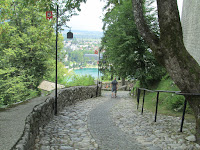On a boat to the islet
On the 3rd day in Bohinj, July 25, I left the pension at 9 am to take a bus at Ukanc going to Ljubljana. Getting off at the Bled bus station, I first rushed in the tourist information to make a day plan for sightseeing around the lake. My priority was to go to see the church on the islet in the middle of the lake by a boat. On a clear Summer morning, the lake was calm and it was agreeable to see from a boat the iconic castle on the cliff rising 130 meters perpendicularly above the lake and the church on the islet gradually getting closer to us on the boat.




The church on the Islet
Around the landing place, there were some young bikini girls enjoying swimming or taking a nap under the sun. Unlike Bohinj lake of its twin lake, the water is said to be warm enough to be 26°C from June through August due to the hot springs near the lake. The lake was created when the Bohinj Glacier retreated after the last Ice age more than 20,000 years ago as well as the lake Bohinj,

It has a great history. The name of Bled was first mentioned in history on April 10th, 1004 when the German Emperor Henry II donated Bled Castle and its lands to Albuin, the Bishop of Brixen in South Tyrol. The Brixen bishops and the Ljubljana Diocese from 1688 on had governed the area until the early 19th century when the Hapsburg took it over. The Church of the Assumption on the islet had been the pilgrimage church of the Mother of God on the Lake and frequented by medieval pilgrims. In the 19th to 20th century, with its beautiful lake and hot springs, the area became the finest health resort in the Austrian empire and attracted many European aristocrats.


The church has been here since the 9th century, which have been expanded and had many alterations with the Gothic style sanctuary consecrated in 1465 and the main Baroque altar carved in 1747. The wishing bell, a popular site for visitors, has been tolling on the island since 1534. Nowadays many young couples come to the church for their wedding and ring the bell for their happy future. The two small square portion of the floor under the bell string was transparent glass and pointed to the existence of an early Slavic cemetery dating back to the 7th century. While I was listening to the guide of the church, I wondered why they built a church on the island which were secluded by the lake water from the nearest villages where most people lived. It would be very troublesome for the inhabitants to come here to pray on every Sunday Mass. Back in Japan, as I wrote this blog, I found an interesting folk legend which says that Bled Island was formerly pastures and meadows where a chapel dedicated to the Virgin Mary stood on a low hill. I thought that this legend might give me a hint to my simple question.
Bled Castle
The boat was waiting for passengers for one hour at the landing place, on which I returned to the shore at 13:20 pm. After a late lunch, I headed for the castle, climbing up a steep path from the lake. Under the hot after-noon summer sunshine, it was almost a hiking with drops of sweat on my forehead. Most visitors seemed to come here by car or bus as there was a bus stop near the castle gate. But it was a nice walking and I could realize how it had been difficult to attack the castle in the medieval time.



Although the most structures of the existing castle were established in the 16th century, its history dates back to the early 11th century when Albuin, the Bishop of Brixen was granted the land. Their reign had lasted for 800 years since. There was also the museum which displayed the collection which traces the lake’s history from prehistoric era to the 19th century. I was very thirsty and could barely refresh myself with a cool beer on the terrace looking out over the lake.

The church on the Island looked graceful and romantic from the castle lookout and I understood why Bled has been attracting so many people since the medieval period who looked for peace of mind and relaxation.
(To be continued; the next is "Ljubljana" )



No comments:
Post a Comment